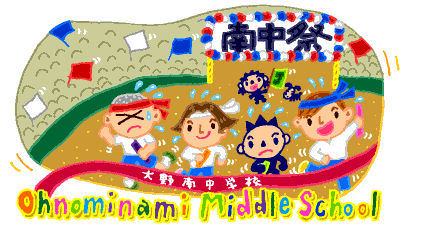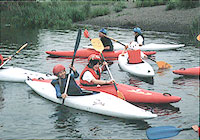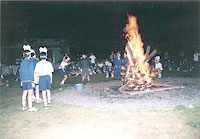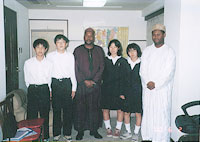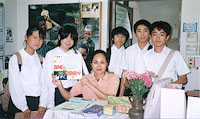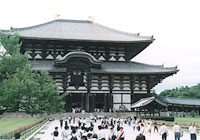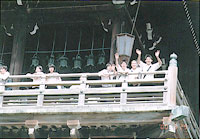Ohnominami Middle School
Out-of-School Study To study and experience things that we cannot normally study in the classroom, we have a "mobile classroom." The first year students are going to spend three days at the Sagami River Nature Village, Wakaayu. There they will experience a wide range of activities, from working in the fields to making cloisonne enamel work, and at the same time they will learn how to live side by side. Second year students will go to Tokyo for their study trip in order to deepen their understanding of international matters. They will be visiting various international institutions in groups of five to six students. The third year students' study trip is intended to give them direct contact with Japan's traditional culture. For their trip in 2000 they went to Kyoto and Nara, two ancient capitals of Japan, for three days.
Memories of the "Mobile Classroom" Mitsuko Kikuchi, First-Year Class 7 The first thing we did in our "hands-on" study was to make a rocket out of a plastic bottle. Making it was not a problem, but the first time I launched it, it only flew a few yards. After a while I realized that the harder I pushed the rubber stopper in, the better the rocket flew. When I pushed the stopper in with all my strength before pumping air in, the rocket flew a surprisingly long way. I haven't forgotten how happy I felt as it shot into the air. The sense of astonishment I experienced and how interesting I found it when I discovered something by myself made a deep impression on me.
When I thought about the three days of the Sagami River Nature Village on the bus back, even though it was a short trip, many memories came flooding back--including the "hands-on" study, chatting with friends at night, the "Know Sagamihara" lectures, writing my report and listening to other students' reports, eating meals together, and doing the jobs assigned to us. I learned so many things at the village. In particular, I was impressed again by the importance of cooperating with all kinds of people, the importance of team spirit. * * * * * * *
Memories of Wakaayu Ayano Uraya, First-Year Class 7 On the first day of our stay at Wakaayu we did orienteering. Several teams competed against each other. At first we were in too much of a hurry and ended to jump to conclusions, but gradually we learned to cooperate successfully with the other group members and by the time we reached the finish we had built up a close relationship. We took a little longer than the time allowed, but as we got all the answers right we felt a sense of achievement. On the second day, we pounded steamed rice to make mochi rice cakes. We carried out the whole process ourselves, from washing the glutinous rice used for mochi to flavoring them. I had never made mochi from beginning to end before. I can remember how we went through the whole process, everyone working hard together on the various stages--cooking the rice, pounding it, sprinkling the finished mochi with sweet soybean flour or soy sauce. The flavor of the mochi made from the rice that I had pounded myself was especially delicious.
Our last "hands-on" study was dying cloth using natural dyes. We tried three kinds of dyes--a blue dye made from indigo, a yellow one made by boiling marigolds, and a dye made from a mixture of any plants we wanted that we could find in the nearby hills. We soaked white handkerchiefs in milk. When they had dried we prepared them for dying in any way we could think of--winding a rubber band around some places, tying knots at the corners, and so on. Then we placed them in saucepans containing the different dyes. I put mine in the marigold dye. When I took it out after about 20 minutes, it had turned a beautiful yellow. The places that had been bound with rubber bands came out as white rings. Where the corners had been knotted, some parts had absorbed the dye and some had not, so that there were somewhat fuzzy edges. Considering it was the first time I had done it, the design had come out very clearly, and it was a great success. The things I experienced during those three days were things that I could only experience at Wakaayu. It was tremendous fun. I think we all learned how to work together in harmony. And on top of that, the bonds linking the students were strengthened by the experience. * * * * * * *
Tokyo Study Trip: Visit to the Nigerian Embassy Second-Year Class 1, Group 4 We made a visit to the Nigerian Embassy in Meguro Ward, Tokyo. All kinds of Nigerian handicrafts were on display inside the Embassy. Each one was unusual and beautiful, so just looking at them was a pleasure.
It was interesting to learn that you must not touch food with your left hand in Nigeria. The right and left hands have their separate roles, and the left hand is used to wash the body. Children are taught from an early age to differentiate the use of the two hands. We thought this was a very interesting difference in customs. There must also be Japanese customs that Nigerian people would find interesting. Something else we learned was that a big fuss is made when twins are born. In Nigeria the bigger a family is, the more it is respected, so when twins are born to a family the delight is twice as great. Everything we learned at the embassy was highly interesting and the visit was a useful experience. The people who talked to us were very kind. We are extremely grateful to them. * * * * * * *
Tokyo Study Trip: Visit to Japan International Volunteer Center Second-Year Class 3, Group 7 We visited the Japan International Volunteer Center located in the Ueno district of Taito Ward, Tokyo. The JIVC is a NPO (Non Profit Organization) that has volunteer workers in seven Asian and African countries. It is involved in grassroots development cooperation and is also tackling the problem of environmental destruction in Asia and Africa. Partly because we are middle school students, the JIVC talked to us mainly about how they are helping children. Recently, the organization has assisted with the construction of clinics in Vietnam and Laos for children who have injuries caused by war or by natural disasters.
We were able to learn about things that we are not conscious of in the normal course of our lives. There are many terrible things happening in the world. I think that each one of us should start doing whatever we can to help. * * * * * * *
Out-of-School Study: Kyoto and Nara Mariko Kobayashi, Third-Year Class 3
On the first day, when we visited Nara Park, the weather was so fine we could not believe our luck. Inside the park we got to see a lot of deer, along with many buildings we had seen in our social studies textbooks. On the second day, we had free time to spend as we pleased. Following the schedule, groups of students went on tours they had planned beforehand. We also did some experiential study, in which we learned various things about Japanese incenses. On the third day we visited Kinkakuji (Temple of the Gold Pavilion) and Ginkakuji (Temple of the Silver Pavilion) temples and the Heian Jingu Shrine (a destination we had decided upon as a class). Unfortunately it was raining, but we were glad to get to see the famous buildings. I think we gained many valuable experiences from our three-day class trip. * * * * * * *
Learning Outside of School: Kyoto and Nara Yuriko Kato, Third-Year Class 1 The streets of Kyoto and Nara have a lot of old Japanese-style buildings. We got a glimpse of old customs, and just walking around was fun. Kanagawa is full of modern buildings, and the pace of life is hurried. When I saw the contrast between my hometown Sagamihara City and these old cities, for some reason I felt nostalgic, rather than surprised.
In Kyoto and Nara, we learned about Japanese traditional culture through some hands-on activities such as drawing pictures on fans, making decorative braided cord, and making traditional Japanese sweets. All of this was extremely interesting. What made the strongest impression on me were the many Buddha statues at the temples. It seemed to me that people back in those days were very skillful, and I think we need to pass this art on to future generations. In the evenings, I chatted and had fun with my friends. We got really rowdy, just as though we were kids again. It seems to me that fun evenings are an essential part of a class trip. * * * * * * * |

